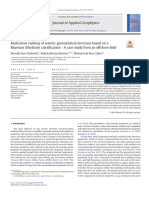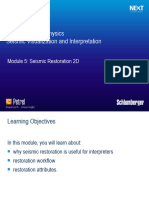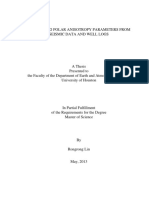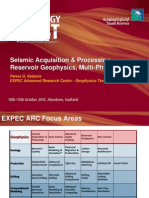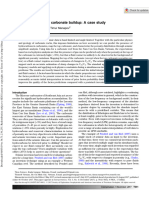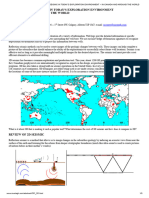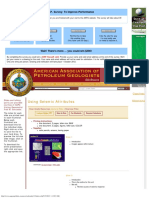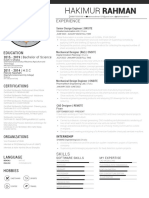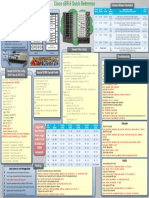AAPG Slide - Well-Seismic Ties - Lecture-2 - by Fred Schroeder.
AAPG Slide - Well-Seismic Ties - Lecture-2 - by Fred Schroeder.
Uploaded by
Muhammad BilalCopyright:
Available Formats
AAPG Slide - Well-Seismic Ties - Lecture-2 - by Fred Schroeder.
AAPG Slide - Well-Seismic Ties - Lecture-2 - by Fred Schroeder.
Uploaded by
Muhammad BilalOriginal Title
Copyright
Available Formats
Share this document
Did you find this document useful?
Is this content inappropriate?
Copyright:
Available Formats
AAPG Slide - Well-Seismic Ties - Lecture-2 - by Fred Schroeder.
AAPG Slide - Well-Seismic Ties - Lecture-2 - by Fred Schroeder.
Uploaded by
Muhammad BilalCopyright:
Available Formats
AAPG Slide Resources: Well-Seismic Ties by Fred Schroeder.
AAPG T.I.P. Survey: To Improve Performance
Please consider taking this four-question survey when you are finished with your visit to the AAPG website. The survey will take about 30
seconds of your time.
Take Survey Now Take Survey In 3 Min Some Other Time Don't Show Again
I'm done I should Remind me to take I like the site the way
and am ready be done in this another time. it is and really see
to take this survey. about 3 minutes. (You have until 30 Sept.) no need to improve it.
Wait! There's more ... you could win $300!
By completing the survey you could win a $300 Visa gift card. Provide us your name and valid email address at the end of this survey. We'll
put your name in a drawing for the card. Your name and email address will not be used for solicitation. It is for notification purposes only.
Only one entry per person. Drawing and notification will take place 1 October 2012.
BLOGS BOOKSTORE BULLETIN CAREER CENTER EDUCATION EXPLORER MEETINGS LIBRARY
---AAPG
---AAPG SITESITE SHORT
SHORT CUTS--- CUTS--- Search
Classifieds
Slides and talking
points are provided Well-Seismic Ties Advertising
courtesy of AAPG
Visiting Geoscientist
Fred W. Schroeder. Downloads Resources Lecture Files | Exercise Files
The notes for each Lecture Slides PPT How to Run For Students Request Solutions
slide are printed next
to each thumbnail.
Below each
Printing Instructions:
thumbnail are
one document, 5 pages, letter size, B&W
download links for
TWO figures, total of 2 pages, letter size, B&W
the individual slide.
Supplies:
Right-click on a link
Scissors (several); Pen or a pencil (for taking notes); Colored pencils: red, yellow, blue, green and #2
to save the file to
(graphite); Eraser
your hard drive. To
preview the full-size
slide image, click on Slide 1
the thumbnail.
To download the Slide to introduce topic: Well-Seismic Ties
entire presentation
right-click and save
the appropriate link.
Download: full size image | PPT slide
Slide 2
Here is the outline for this lecture
We will discuss:
Objectives of the seismic - well tie
http://www.aapg.org/slide_resources/schroeder/7/index.cfm[9/23/2012 12:09:13 AM]
AAPG Slide Resources: Well-Seismic Ties by Fred Schroeder.
What is a good well-seismic tie?
Comparing well with seismic data
Preparing well data
Preparing seismic data
How to tie synthetics to seismic data.
Pitfalls
Download: full size image | PPT slide
Slide 3
The objectives for performing a well-seismic tie are listed here
Wells, of course, are registered in units of depth – feet or meters
Seismic data is recorded and usually worked with a vertical scale
of 2-way travel time
To relate well data to seismic data, and vice versa, we have to
handle this change in vertical scale units
Thus:
Well-seismic ties allow well data, measured in units of
depth, to be compared to seismic data, measured in units
of time
Download: full size image | PPT slide This allows us to relate horizon tops identified in a well with
specific reflections on the seismic section
We use sonic and density well logs to generate a synthetic
seismic trace
The synthetic trace is compared to the real seismic data
collected near the well location
The well-seismic tie is the bridge we need to go from seismic
“wiggles” to the rocks that produced the “wiggles” and our
interpretation of the subsurface geology
Slide 4
The purpose and required accuracy of a well-seismic tie varies
with the stage of our studies
If we are doing regional mapping, e.g., mapping a significant
erosional unconformity or a flooding surface, then our tie does not
need to be very precise, within 1 or 2 seismic cycles (peaks or
troughs) – and the seismic data quality does not have to be very
good
In the exploration stage, we would like to tie well data, e.g., the top
of a stratigraphic horizon/marker within ½ a cycle
This requires good seismic data quality
Download: full size image | PPT slide In the exploitation stage (development & production), we need to
not only know the seismic event within ½ a cycle, but the shape of
the real and modeled seismic trace should be quite similar
For this, we need very good seismic data quality
If we obtain a good character (shape) tie between the real
and synthetic traces, then:
We would then be able to extract various seismic
attributes (measures of the seismic wavelets) to
predict rock and fluid properties
We may also be able to use a process called
inversion to transform the seismic data into an
estimate of the rock properties in cross-section
views or as a 3D volume (if we have 3D seismic
data)
Slide 5
This slide illustrates the differences in measurements between
seismic and well data
For seismic data, measurements are usually referenced to a
http://www.aapg.org/slide_resources/schroeder/7/index.cfm[9/23/2012 12:09:13 AM]
AAPG Slide Resources: Well-Seismic Ties by Fred Schroeder.
common surface elevation (typically sea level) and are recorded in
units of two-way travel time
Zero time is when a shot is fired
We then measure the time it takes for the acoustic energy
to travel down to a reflection surface and back up to the
receiver at the surface
For well/log data, measurements are made relative to a device on
Download: full size image | PPT slide the drill rig called the Kelly Bushing (kb)
Depths are in feet or meters along the well bore
If the well is not purely vertical, then we differentiated
between ‘measured depth’ and ‘true vertical depth,’ which
has to be computed
Slide 6
This slide compares different aspects of seismic and well/log data
Seismic data samples areas and volumes within the earth; wells
sample points along the well bore
Seismic data is low frequency (5 to 60 Hz); a log that measures
rock velocity uses frequencies that are much higher
Vertical resolution is quite different – for seismic we can resolve
layers that are 15 to 100 m thick; with logs we can resolve layers 2
cm to 2 m thick
Horizontal resolution for seismic... for wells...
Seismic data measures... well data measures...
Download: full size image | PPT slide And, as we have already discussed, seismic is measured in two-
way travel time; well data is in depth (ft or meters)
Slide 7
Here is a simple flow chart for performing a:well-seismic tie
At the top is our seismic data – the raw field data is processed to
get us images of the subsurface
The processed data gives us a “real” seismic trace at the
location of the well we want to tie
As part of the data processing, we can get an estimate of
the shape of the seismic pulse
Near the bottom is the well data, which may need some
processing/editing
The well data we need come from the sonic log (gives us
Download: full size image | PPT slide velocity information) and one of several density logs
We may also have check shots from the well – more on
check shots on the next slide
If we do not have an estimated pulse from the seismic data
processing, we can use a standard (external) pulse shape of a
user-defined phase and frequency
Computer programs combine the sonic and density log data with
the estimated or external pulse to generate a “synthetic” or
“modeled” seismic trace
We then compare the real and synthetic traces and note how well
they match
If the match is good enough for our purposes, we can then relate
one data set to the other – well to seismic OR seismic to well
Slide 8
What is check shot data?
We would like to have some calibration between well depth and
seismic time, if possible
We do this by conducting a check shot survey in a well bore
It is rather simple in concept:
We lower a geophone (listening device) into a well and
record its depth
We then fire a shot at the surface and record the one-way
http://www.aapg.org/slide_resources/schroeder/7/index.cfm[9/23/2012 12:09:13 AM]
AAPG Slide Resources: Well-Seismic Ties by Fred Schroeder.
travel time to the geophone
We can do this with the geophone at multiple depths
Download: full size image | PPT slide This allows us to calibrate the time-depth relationship
For example, we might find that when the geophone was at
2000 meters the one-way time was 0.9 seconds
A check shot survey with a large number of closely-spaced
geophone positions is called a VSP – a vertical seismic profile
Slide 9
We need a pulse to generate a synthetic trace
There are two options
It is best to use software during or after data processing to
estimate the pulse for a given window of real seismic data
This window would be at the well location and near
the depth of our primary zone of interest (e.g., our
main reservoir)
The second option is to use a standard pulse shape with
some user-specified parameters
This is a quicker method that is fine if we do not
Download: full size image | PPT slide need to match wavelet shape – development and
production stages
There are three basic pulse shapes:
Minimum phase is where the wavelet starts at the
position of the reflection coefficient (as shown in the
diagram)
Zero phase is where the wavelet is centered on the
reflection coefficient
Quadrature phase is the zero phase pulse shifted -
90 degrees – looks a bit like the minimum phase but
is different
For a standard pulse, the user has to input two parameters:
The polarity – does an increase in impedance give a peak
or a trough, and
A central frequency (e.g., 18 Hz)
Since the seismic pulse changes in the earth with depth (e.g., due
to attenuation), you may have to generate several synthetics based
on different estimated or standard pulses – one for shallow targets,
another for intermediate
Slide 10
This summarizes the seismic modeling process
At a given location, e.g., at well A, the earth consists of layers with
varying lithologies
Well logs give us velocity and density as a function of depth, which
we ‘block’ to capture the significant changes
Next we compute impedance as a function of depth
From impedance we can calculate the reflection coefficients
We define a pulse – extracted or estimated
The reflection coefficient series is convolved with the pulse to get
individual wavelets – the response of each reflection coefficient to
Download: full size image | PPT slide the pulse
The individual wavelets are summed to give us the synthetic
seismic trace
Slide 11
http://www.aapg.org/slide_resources/schroeder/7/index.cfm[9/23/2012 12:09:13 AM]
AAPG Slide Resources: Well-Seismic Ties by Fred Schroeder.
Rather then inputting the sonic and density logs directly, we ‘block’
the logs to capture significant changes
This helps us associate major lithologic changes with specific
peaks or troughs
The blocking process does not “corrupt” the synthetic trace
As shown here within the magenta rectangle, closely-spaced
reflection coefficients of opposite sign results in destructive
interference and, as a result, the closely-spaced RCs have almost
no response on the final synthetic trace
Our experience is that logs can be blocked with a 3 m (10 ft)
Download: full size image | PPT slide minimum layer spacing
Slide 12
Here is an example where we have cut a seismic line into a left
and right portion at a well and placed a synthetic trace in a gap at
the well location
On the color seismic, red is a peak; black is a trough
Download: full size image | PPT slide
Slide 13
Going through the steps, we:
Break the seismic line at the well location, forming a small
gap within which we can display the synthetic trace
If we have 2D seismic and the well is not actually on the
seismic line, we project the position in along strike
Download: full size image | PPT slide
Slide 14
The seismic data and the well data may have different datums – so
we may have to apply an up/down shift
If check shot data is available, our shift should be small since we
have some time-depth calibration
If we do not have check shot data, we may need a larger up/down
shift
For this example, the strong peak (black) 2/3 down on the synthetic
looks like it should correlate with the strong red cycle (peak) on the
real sesimic data about ½ cycle lower
Download: full size image | PPT slide
Slide 15
Here we have shifted the synthetic down to tie the strong peak on
both data sets
We would look further up & down the trace to see if the other
seismic cycles seem to line up and if the wavelet characters are
similar
Here the tie looks good enough for regional mapping &
exploration, but not good enough for development & production
uses
http://www.aapg.org/slide_resources/schroeder/7/index.cfm[9/23/2012 12:09:13 AM]
AAPG Slide Resources: Well-Seismic Ties by Fred Schroeder.
Download: full size image | PPT slide
Slide 16
We may be justified to move the synthetic traces a few traces to
the left or right.
One good reason to move the synthetic is if the well is not actually
on the seismic line (2D seismic survey)
For 2D or 3D seismic data, there could be some positional errors
(seismic or well) or the seismic data may not be adequately
migrated
The older the data, the more likely the positions are not accurate
(pre-GPS technology)
For this example, it looks like we get a better tie by moving the
Download: full size image | PPT slide synthetic about 10 traces to the right (~125 meters)
Slide 17
We accept the tie that gives the best character (wavelet) match
with the least amount of vertical and lateral shifting
The strong peak in this example is the contact between reservoir
quality sands below and a marine shale (good seal) above
Thus we can relate markers in the well (top of reservoir) with a
specific cycle on the seismic line and map this boundary on the
rest of our seismic data
Download: full size image | PPT slide
Slide 18
There are a number of assumptions that we make in generating a
synthetic trace
For the real seismic, we assume that:
The seismic data is noise free
There are no multiples
Relative amplitudes are preserved, i.e., the amplitude is
proportional to the impedance change
Zero-offset section
For the synthetic seismic trace, we assume:
Blocked logs are representative of the earth sampled by the
Download: full size image | PPT slide seismic data
Normal incidence (zero offset) reflection coefficients
Multiples are ignored
The pulse experiences no transmission losses or
absorption
The rocks are isotropic (vertical and horizontal velocities
are equal)
Slide 19
What does it mean if the synthetic trace does not match the real
seismic trace?
Here are some of the most common pitfalls
Error in well or seismic line location
Log data quality
washout zones, drilling-fluid invasion effects
Seismic data quality
noise, multiples, amplitude gain, migration, etc
Incorrect pulse
Polarity, frequency, and phase
Download: full size image | PPT slide Try a different pulse; use extracted pulse
Incorrect 1-D model
Blocked logs, checkshots need further editing
Incorrect start time or improper datuming
Amplitude-Versus-Offset effects
http://www.aapg.org/slide_resources/schroeder/7/index.cfm[9/23/2012 12:09:13 AM]
AAPG Slide Resources: Well-Seismic Ties by Fred Schroeder.
Bed tuning
3-D effects not fully captured by seismic or well data
Contact Us | Energy Facts | Links | Site Search | Calendar | RSS | Site Feedback | Terms of Use
AAPG : 1444 S. Boulder : Tulsa, OK 74119 : USA | Phone: 1 918 584-2555 | Toll Free US & Canada: 1 800 364 2274 | Fax 1 918 580-2665
http://www.aapg.org/slide_resources/schroeder/7/index.cfm[9/23/2012 12:09:13 AM]
You might also like
- How To Make Sense of Any Mess - Information Architecture For EverybodyDocument191 pagesHow To Make Sense of Any Mess - Information Architecture For Everybody2sz4l9aiNo ratings yet
- DIT 0411 Mobile Computing Outline - Jan 2023Document4 pagesDIT 0411 Mobile Computing Outline - Jan 2023Stephen MainaNo ratings yet
- AAPG Slide - Lecture-8 - Seismic Resolution - by Fred Schroeder.Document7 pagesAAPG Slide - Lecture-8 - Seismic Resolution - by Fred Schroeder.Muhammad BilalNo ratings yet
- D. Herron - Tying A Well Seismic Using A Blocked Sonic LogDocument7 pagesD. Herron - Tying A Well Seismic Using A Blocked Sonic LogBetza2No ratings yet
- AAPG Slides - Lecture-12 - Seismic Facies Analysis - Interpretation - by Fred Schroeder.Document6 pagesAAPG Slides - Lecture-12 - Seismic Facies Analysis - Interpretation - by Fred Schroeder.Muhammad BilalNo ratings yet
- Caers SlidesDocument37 pagesCaers SlidesThinh OnNo ratings yet
- 2010 04 RECORDER Model Based Seismic InversionDocument12 pages2010 04 RECORDER Model Based Seismic Inversiondanjohhn0% (1)
- Geology II Lecture SlidesDocument62 pagesGeology II Lecture Slidesbikki rayNo ratings yet
- Benefits of Integrating Rock Physics With PetrophysicsDocument5 pagesBenefits of Integrating Rock Physics With PetrophysicshendrabsNo ratings yet
- Catuneanu Et Al 2011-SequenceDocument74 pagesCatuneanu Et Al 2011-SequenceSamille SouzaNo ratings yet
- Well SeismictiesDocument19 pagesWell SeismictiesEzzadin BabanNo ratings yet
- AVO ResponsesDocument5 pagesAVO ResponsesMuhammad Arief HarvityantoNo ratings yet
- T Im E: Synthetic TraceDocument19 pagesT Im E: Synthetic TraceRAAJARSHE PRAKAASH GUPTANo ratings yet
- TG Structural Interpretation Ganjil 20-21Document79 pagesTG Structural Interpretation Ganjil 20-21andaruNo ratings yet
- 07 Eage Edudaysbgu2013 Shaleoil Handout PDFDocument67 pages07 Eage Edudaysbgu2013 Shaleoil Handout PDFkusbarotoNo ratings yet
- Sismica InversionDocument13 pagesSismica InversionJorge MartinezNo ratings yet
- New Methods IN Shallow Seismic Reflection: Zuhar Zahir Tuan HarithDocument336 pagesNew Methods IN Shallow Seismic Reflection: Zuhar Zahir Tuan Harithmariam qaherNo ratings yet
- Basic Well LogsDocument70 pagesBasic Well Logsupasana9No ratings yet
- StartDocument1 pageStartwajdigeo216No ratings yet
- 08 1st SEISINV Course2015 Simultaneous InversionDocument33 pages08 1st SEISINV Course2015 Simultaneous InversionSony BintangNo ratings yet
- Uqgd6lDocument25 pagesUqgd6lKonul AlizadehNo ratings yet
- The Application of Outcrop Analogues in Geological ModellingDocument25 pagesThe Application of Outcrop Analogues in Geological ModellingDjuan RochmanNo ratings yet
- Day 4Document39 pagesDay 4tonystark8052No ratings yet
- True Depth Conversion CSEGRecorder Nov 2001Document10 pagesTrue Depth Conversion CSEGRecorder Nov 2001arungh007No ratings yet
- Seismic Attributes A ReviewDocument7 pagesSeismic Attributes A ReviewJanaína Anjos MeloNo ratings yet
- Lin Thesis 2013Document101 pagesLin Thesis 2013Az RexNo ratings yet
- Tuning Strech AVODocument14 pagesTuning Strech AVOjose_regueiro_4No ratings yet
- Lecture 7 Density LogDocument50 pagesLecture 7 Density LogHossein TashaNo ratings yet
- Constrained Rock Physics Modeling: SPECIALSECTION: Rock Physics Rock Physics SPECIALSECTION: Rock PhysicsDocument5 pagesConstrained Rock Physics Modeling: SPECIALSECTION: Rock Physics Rock Physics SPECIALSECTION: Rock PhysicsIftikhar Satti100% (1)
- Seismic Inversion Mind MapDocument1 pageSeismic Inversion Mind MapAdel ShakerNo ratings yet
- A Simplified Approach To Understanding The Kalman Filter TechniqueDocument24 pagesA Simplified Approach To Understanding The Kalman Filter TechniquemishraaoNo ratings yet
- Borehole Image in Oil Gas 1668167265Document45 pagesBorehole Image in Oil Gas 1668167265Dhani de EngineurNo ratings yet
- Petrel Software Training Course CurriculumDocument2 pagesPetrel Software Training Course CurriculumJayavelan JayavelanNo ratings yet
- 01-1 Reservoir CharacterizationDocument87 pages01-1 Reservoir Characterizationngmthai2003No ratings yet
- 2 - Volumetric Dip and AzimuthDocument20 pages2 - Volumetric Dip and AzimuthSagnik Basu RoyNo ratings yet
- Stacking - in - Seismic - Processing (1) 111Document21 pagesStacking - in - Seismic - Processing (1) 111Kwame PeeNo ratings yet
- AVO - Current Practice and PitfallsDocument2 pagesAVO - Current Practice and PitfallsMahmoud EloribiNo ratings yet
- 0413 GC2010 Seismic Attributes for 3DDocument4 pages0413 GC2010 Seismic Attributes for 3DShujaat AliNo ratings yet
- 2271 Extended Elastic ImpedanceDocument58 pages2271 Extended Elastic ImpedanceSk SinghNo ratings yet
- Introduction Well LoggingDocument40 pagesIntroduction Well LoggingTajuddin MohammedNo ratings yet
- 52 Things Well-TiesDocument10 pages52 Things Well-TiesMark MaoNo ratings yet
- Random Noise Reduction FXYDocument3 pagesRandom Noise Reduction FXYAwalNo ratings yet
- GEY 462 Seismic and Well LoggingDocument61 pagesGEY 462 Seismic and Well Loggingayodejikomolafe2016No ratings yet
- NDX SantanaDocument5 pagesNDX SantanaAz RexNo ratings yet
- Seismic Acquisition & Processing Reservoir Geophysics, Multi-PhysicsDocument32 pagesSeismic Acquisition & Processing Reservoir Geophysics, Multi-PhysicsDjibril Idé AlphaNo ratings yet
- Avo Modelling PDFDocument14 pagesAvo Modelling PDFZahra AnnaqiyahNo ratings yet
- RokDoc Product Sheet v12Document2 pagesRokDoc Product Sheet v12c_b_umashankarNo ratings yet
- sonicDocument56 pagessonicDHANANJAINo ratings yet
- 9 Subsurface Methods PDFDocument20 pages9 Subsurface Methods PDFAnonymous iZx83pFsOrNo ratings yet
- 2017 Seismic Inversion of A Carbonate Buildup A Case StudyDocument12 pages2017 Seismic Inversion of A Carbonate Buildup A Case StudyTumpal B NainggolanNo ratings yet
- Magnetic MethodDocument91 pagesMagnetic MethodFisseha KebedeNo ratings yet
- The Value of 3d Seismic in Today's Exploration Environment - in Canada and Around The WorldDocument5 pagesThe Value of 3d Seismic in Today's Exploration Environment - in Canada and Around The WorldmythygpbhuNo ratings yet
- CourseDocument287 pagesCourseYahya ManssourNo ratings yet
- 3D Seismic Facies Generated From Independent Seismic Attributes Using The Neural Network Technique - 6659949 - EDIT - 6659949 - 01Document9 pages3D Seismic Facies Generated From Independent Seismic Attributes Using The Neural Network Technique - 6659949 - EDIT - 6659949 - 01shkhawatNo ratings yet
- Chapter 1: The Tectonic Stress Field: TopicsDocument38 pagesChapter 1: The Tectonic Stress Field: TopicszztannguyenzzNo ratings yet
- Geophysical exploration and seepage for dam engineeringDocument50 pagesGeophysical exploration and seepage for dam engineeringSaiful HakimNo ratings yet
- 002 M3 Import 2007 PotsdamDocument22 pages002 M3 Import 2007 PotsdamJuan Ignacio BoggettiNo ratings yet
- Basin Analysis: Principles and Application to Petroleum Play AssessmentFrom EverandBasin Analysis: Principles and Application to Petroleum Play AssessmentRating: 4.5 out of 5 stars4.5/5 (3)
- Reservoir Engineering of Conventional and Unconventional Petroleum ResourcesFrom EverandReservoir Engineering of Conventional and Unconventional Petroleum ResourcesNo ratings yet
- Physiography of OceanDocument4 pagesPhysiography of OceanMuhammad BilalNo ratings yet
- Acquisition Report - UpdatedDocument42 pagesAcquisition Report - UpdatedMuhammad BilalNo ratings yet
- AAPG Slides - Lecture-17 - Which Prospects To Drill - by Fred Schroeder.Document4 pagesAAPG Slides - Lecture-17 - Which Prospects To Drill - by Fred Schroeder.Muhammad BilalNo ratings yet
- Acquisition Companies ListingDocument2 pagesAcquisition Companies ListingMuhammad BilalNo ratings yet
- Working For Deeper HorizonDocument7 pagesWorking For Deeper HorizonMuhammad BilalNo ratings yet
- AAPG Slides - Lecture-17 - Carbonate Lease Sale - by Fred Schroeder.Document2 pagesAAPG Slides - Lecture-17 - Carbonate Lease Sale - by Fred Schroeder.Muhammad BilalNo ratings yet
- Bahria University 2Document63 pagesBahria University 2Muhammad BilalNo ratings yet
- Seismic Reprocessing Programme FinalDocument32 pagesSeismic Reprocessing Programme FinalMuhammad BilalNo ratings yet
- AAPG Slides - Lecture-3 - Types of Data - by Fred Schroeder.Document6 pagesAAPG Slides - Lecture-3 - Types of Data - by Fred Schroeder.Muhammad BilalNo ratings yet
- AAPG Slides - Lecture-13 - Using Seismic Attributes - by Fred SchroederDocument11 pagesAAPG Slides - Lecture-13 - Using Seismic Attributes - by Fred SchroederMuhammad BilalNo ratings yet
- AAPG Slides - Lecture-2 - The Basics of Prospecting - by Fred Schroeder.Document4 pagesAAPG Slides - Lecture-2 - The Basics of Prospecting - by Fred Schroeder.Muhammad BilalNo ratings yet
- AAPG Slides - Lecture-10 - Interpretation - Structural Analysis - by Fred Schroeder.Document7 pagesAAPG Slides - Lecture-10 - Interpretation - Structural Analysis - by Fred Schroeder.Muhammad BilalNo ratings yet
- AAPG Slides - Lecture-0 - An Introduction To The Hunt For Oil - by Fred Schroeder.Document3 pagesAAPG Slides - Lecture-0 - An Introduction To The Hunt For Oil - by Fred Schroeder.Muhammad BilalNo ratings yet
- Deconvolutio-In-Practice From XsgeoDocument7 pagesDeconvolutio-In-Practice From XsgeoMuhammad BilalNo ratings yet
- AAPG Slides - Lecture-12 - Data Analysis - Interpretation - by Fred Schroeder.Document11 pagesAAPG Slides - Lecture-12 - Data Analysis - Interpretation - by Fred Schroeder.Muhammad BilalNo ratings yet
- AAPG Slides - Lecture-11 - Stratigraphic Analysis - Interpretation - by Fred Schroeder.Document6 pagesAAPG Slides - Lecture-11 - Stratigraphic Analysis - Interpretation - by Fred Schroeder.Muhammad BilalNo ratings yet
- ProcessingFlow Presentation From Xsgeo-Dot-Com 1999Document6 pagesProcessingFlow Presentation From Xsgeo-Dot-Com 1999Muhammad BilalNo ratings yet
- AAPG Slides - Lecture-1 - The Focus of Industry - by Fred Schroeder.Document6 pagesAAPG Slides - Lecture-1 - The Focus of Industry - by Fred Schroeder.Muhammad BilalNo ratings yet
- AAPG Slide - Lecture-9 - Overview of Seismic Interpretation - by Fred Schroeder.Document3 pagesAAPG Slide - Lecture-9 - Overview of Seismic Interpretation - by Fred Schroeder.Muhammad BilalNo ratings yet
- Fundamentals of Seismic AcquisitionDocument4 pagesFundamentals of Seismic AcquisitionMuhammad BilalNo ratings yet
- References Seismic Presentation From Xsgeo-Dot-Com 1999Document2 pagesReferences Seismic Presentation From Xsgeo-Dot-Com 1999Muhammad BilalNo ratings yet
- Basic Processing - Definitions - Presentation - From - Xsgeo-Dot-Com - 1999Document9 pagesBasic Processing - Definitions - Presentation - From - Xsgeo-Dot-Com - 1999Muhammad BilalNo ratings yet
- Marine SeismicDocument86 pagesMarine SeismicMuhammad Bilal100% (1)
- SEG-D Rev3 0 Format Jun2012Document186 pagesSEG-D Rev3 0 Format Jun2012Muhammad BilalNo ratings yet
- Time and Depth ConversionDocument8 pagesTime and Depth ConversionMuhammad BilalNo ratings yet
- NOC Format For EmployeeDocument2 pagesNOC Format For EmployeeMuhammad BilalNo ratings yet
- 3 Seismic Data Processing: Reasons To MigrateDocument72 pages3 Seismic Data Processing: Reasons To MigrateMuhammad BilalNo ratings yet
- The Economics of Geophysical ApplicationsDocument6 pagesThe Economics of Geophysical ApplicationsMuhammad BilalNo ratings yet
- ReferatDocument48 pagesReferatIntanNo ratings yet
- Vsphere Esxi Vcenter Server 70 Vsphere Lifecycle ManagerDocument173 pagesVsphere Esxi Vcenter Server 70 Vsphere Lifecycle ManagerAthi MaddyNo ratings yet
- Jahnavi. K (Resume)Document3 pagesJahnavi. K (Resume)vinay adhikariNo ratings yet
- Rehva: Federation of European Heating and Air-Conditioning AssociationsDocument57 pagesRehva: Federation of European Heating and Air-Conditioning AssociationsmradiliNo ratings yet
- US Army FM 34-8-2 - Intelligence Officers Handbook 1Document212 pagesUS Army FM 34-8-2 - Intelligence Officers Handbook 1imgstacke100% (19)
- SAP Funds Management - Period Based Encumbrance TrackingDocument6 pagesSAP Funds Management - Period Based Encumbrance TrackingKathiresan NagarajanNo ratings yet
- Hacking The Android APK TrainingDocument2 pagesHacking The Android APK TrainingibrahimadeyinkaNo ratings yet
- Contents of ThesisDocument75 pagesContents of ThesisOlyadNo ratings yet
- Service: ManualDocument23 pagesService: ManualMoises VivancoNo ratings yet
- Pramac Autostart ManualDocument2 pagesPramac Autostart ManualSOS100% (1)
- Frayer Vocabulary Model Consecutive Integer Problems Work ProblemsDocument18 pagesFrayer Vocabulary Model Consecutive Integer Problems Work ProblemsJoyce Ann May BautistaNo ratings yet
- Resume UngerDocument2 pagesResume UngerMichelle ClarkNo ratings yet
- Instruction Manual: Digital CameraDocument201 pagesInstruction Manual: Digital CameraalelendoNo ratings yet
- TC51 and TC56 Touch ComputerDocument4 pagesTC51 and TC56 Touch ComputerWillemVandeputNo ratings yet
- NPC Pia 0618Document14 pagesNPC Pia 0618A Sanchez100% (1)
- Hakimur Rahman, ResumeDocument1 pageHakimur Rahman, ResumeHakimur RahmanNo ratings yet
- Job Seek WebsiteGP AyaaaDocument95 pagesJob Seek WebsiteGP AyaaaAya EltawilNo ratings yet
- ErationCard - AAY - RationCardNo - 0103419166 - 89659476 - 04 - 09 - 2023 13 - 46 - 15Document1 pageErationCard - AAY - RationCardNo - 0103419166 - 89659476 - 04 - 09 - 2023 13 - 46 - 15mukherjee.sujata758No ratings yet
- MU156 Diagram 7Document3 pagesMU156 Diagram 7Allison Margaux QwertyNo ratings yet
- Sugar WorksDocument46 pagesSugar WorksALINDA BRIANNo ratings yet
- AfismDocument4 pagesAfismlaurajoybenifieldNo ratings yet
- Cisco Certified CyberOps Professional Certification ProgramDocument3 pagesCisco Certified CyberOps Professional Certification ProgrambocanerNo ratings yet
- The EconomistDocument27 pagesThe EconomistMd Arifur RahmanNo ratings yet
- Form Pendaftaran Kejurnas Jatim Open 2019Document2 pagesForm Pendaftaran Kejurnas Jatim Open 2019Rkrmt Fredhiantoro M KadityaNo ratings yet
- BL24C32Document15 pagesBL24C32no188No ratings yet
- LinkedIn HackingDocument46 pagesLinkedIn Hackingjeff_roberts881No ratings yet
- Online Web Based Condominium House Rental SystemDocument92 pagesOnline Web Based Condominium House Rental SystemTibebu AntenehNo ratings yet
- BRKSPG 2505 PosterDocument1 pageBRKSPG 2505 PosterMac KaNo ratings yet















